FALSE POPES EXPOSED
BY
PAPAL INFALLIBILITY
It is an article of faith that Jesus Christ founded only one Church – the Holy Catholic Church. To It alone He gave the mission to preserve, whole and intact, the truths He taught man. For over 1900 years the Church has been faithful to this mission and has fought off every assault of her enemies to compromise these truths. Then in the 1960’s we saw a sudden about-face. Now the Church’s hierarchy is not only no longer resisting these incursions against the Faith, but rather we find her actually embracing the very errors she had so strenuously fought against for centuries. What are we to make of this change of course and confusing behavior? Can the Church founded by Christ actually do this?
ONE GOD, ONE TRUTH, ONE CHURCH, ONE DOCTRINE
We know from Sacred Scripture and Tradition that God is unchanging Truth, “For I am the Lord, and I change not,”1 and that He can never “deceive nor be deceived.”2 We also know that truths revealed by God are absolute and incapable of change, “Heaven and earth shall pass away, but My words shall not pass away.” (Mark 13:31)
We further know from Sacred Scripture and Tradition that Jesus Christ founded on earth a Church − the Catholic Church3 − to continue the work of redemption. “Upon this rock I will build My Church and the gates of Hell shall not prevail against It.” (Matt. 16:18) Christ promised to be with His Church “all days, even until the consummation of the world.” (Matt. 28:20) It was only to the Catholic Church that Jesus Christ gave His Authority. “He that heareth you heareth Me.” (Luke 10:16) “Whatsoever thou shalt bind upon earth, it shall be bound also in Heaven; and whatsoever thou shalt loose upon earth, it shall be loosed also in Heaven.” (Matt. 16:19) He furthermore promised to Saint Peter the Apostle, and to all his lawful successors, that the Holy Ghost would preserve them from ever teaching error. “I have prayed for thee, that thy faith fail not, and thou, being once converted, confirm thy brethren.” (Luke 22:32) This promise was not temporary, but for all times: “I will ask the Father, and He shall give you another Paraclete, that He may abide with you forever: the Spirit of Truth.” (John 14:16-17)
This preservation from ever teaching error is called infallibility and was solemnly defined by the Vatican Council (1870):
“We [Pope Pius IX] teach and define as a divinely revealed dogma that when the Roman Pontiff speaks ex cathedra, that is, when, in the exercise of his office as shepherd and teacher of all Christians, in virtue of his supreme apostolic authority, he defines a doctrine concerning faith or morals to be held by the whole Church, he possesses, by the divine assistance promised to him in blessed Peter, that infallibility which the Divine Redeemer willed His Church to enjoy in defining doctrine concerning faith or morals. Therefore, such definitions of the Holy Roman pontiff are of themselves, and not by the consent of the Church, irreformable. So then, should anyone, which God forbid, have the temerity to reject this definition of ours: let him be anathema.”
This is at the core of the problem for those who hold to traditional Catholicism – infallibility: the infallibly defined doctrines taught by the One, Holy, Catholic, Apostolic Church before “Vatican Council II”4 and the doctrines taught since. In examining the teachings of the Church both before and after Vatican Council II, we are faced with irreconcilable differences – irreconcilable doctrinal differences. Some examples of these doctrinal differences can be found in the doctrines of “no salvation outside of the Catholic Church,” the doctrines on interfaithing with other religions, the doctrines on the Sacraments, etc. So how are we to reconcile these doctrinal differences? Who and what are we to believe?
PAPAL INFALLIBILITY
It is a simple matter of historical record that for over 1,900 years the Church and Her 260 plus popes, that is, from St. Peter through His Holiness, Pius XII, have taught ONE set of doctrines. and that since John XXIII and the introduction of Vatican Council II, CONTRADICTORY doctrines have been introduced.
So, how does one reconcile this disparity of teaching in view of papal infallibility? This is, how can infallible popes be teaching Church doctrines today in opposition to how infallible popes have taught these same doctrines in the past? Right reasoning allows for the following possibilities:
- The Church was wrong, popes are fallible;
- St. Peter and his 260 successors in office have all taught error and only the last 5 “popes” have been teaching truth;
- The last 5 “popes” taught error and the first 261 popes have taught Truth.
The first possibility is not a possibility at all, for papal infallibility was solemnly decreed in Vatican Council I.
The second possibility is as equally impossible as the first, because it would nullify Christ’s promise that the “Spirit of Truth” would be with His Church “forever.”5 Jesus Christ−the Way, the Truth and the Life−would thereby be turned into the universal deceiver of mankind. That would be blasphemy.
So that leaves us with the only other possible answer: that the five “popes” who came after Pope Pius XII, who have introduced new and contradictory doctrines, are not true popes. This will be proved shortly. But first we must consider the following question: how could this happen?

October 4, 1965.
Paul VI turns over to the United Nations the Papal Tiara (a symbol of the papacy) and called the United Nations the “the last, the best hope of mankind.”
This last, best hope of mankind is not Catholicism. It is not the Virgin Mary. It is not even God! Rather this best, last hope of mankind was a body of men who were largely anti-Catholic, and among their number were even some who had been guilty of spilling the blood of Catholics.
|
|
Popes Are Infallible, Not Impeccable
As noted above, while popes are preserved by the Holy Ghost from teaching error to us, they are not preserved by the Holy Ghost from falling into error themselves. Under certain conditions popes are absolutely infallible, but under no conditions are they impeccable. Like the rest of us, they are capable of all sin, including the sin of heresy.
As to how a pope could commit heresy, we have two factual possibilities: 1) He was guilty of heresy prior to his election to the papacy, or 2), he fell into personal heresy after his election. The end result for either scenario is the same.
Possibility #1 – A Heretic is Elected Pope
Fearing infiltration into the Church by those who held heretical beliefs or who had strayed from the Catholic Faith, His Holiness, Pope Paul IV, by publishing his Apostolic Constitution, forever excluded them from holding any office in the Church’s hierarchy under any conditions whatsoever:
“[by this Our Constitution, which is to remain valid in perpetuity We enact, determine, decree and define:] that if ever at any time it shall happen that any Bishop, even if he be acting as an Archbishop, Patriarch or Primate; or any Cardinal of the aforesaid Roman Church, or, as has already been mentioned, any legate, or even the Roman Pontiff, prior to his promotion or his elevation as Cardinal or Roman Pontiff, has deviated from the Catholic Faith or fallen into some heresy:
- the promotion or elevation, even if it shall have been uncontested and by the unanimous assent of all the Cardinals, shall be null, void and worthless;
- it shall not be possible for it to acquire validity (nor for it to be said that it has thus acquired validity) through the acceptance of the office, of consecration, of subsequent authority, nor through possession of administration, nor through the putative enthronement of a Roman Pontiff, or Veneration, or obedience accorded to such by all, nor through the lapse of any period of time in the foregoing situation;
- it shall not be held as partially legitimate in any way;
- to any so promoted to be Bishops, or Archbishops, or Patriarchs, or Primates or elevated as Cardinals, or as Roman Pontiff, no authority shall have been granted, nor shall it be considered to have been so granted either in the spiritual or the temporal domain;
- each and all of their words, deeds, actions and enactments, howsoever made, and anything whatsoever to which these may give rise, shall be without force and shall grant no stability whatsoever nor any right to anyone;
- those thus promoted or elevated shall be deprived automatically, and without need for any further declaration, of all dignity, position, honor, title, authority, office and power.” (Cum ex Apostolatus Officio, 1559)
The Code of Canon Law contains the same proscription:
“All offices shall be vacant ipso facto [automatically] by tacit resignation in the following cases: (4) If a cleric has publicly lapsed from the Catholic Faith;” (Canon 188)
The principle behind this is explained by Saint Robert Bellarmine, Cardinal and Doctor of the Church:
“This principle is most certain. The non-Christian cannot in any way be Pope, as Cajetan himself admits.6 The reason for this is that he cannot be head of what he is not a member; now he who is not a Christian is not a member of the Church, and a manifest heretic is not a Christian, as is clearly taught by St. Cyprian,7 St. Athanasius,8 St. Augustine,9 St. Jerome,10 and others; therefore the manifest heretic cannot be Pope.” (De Romano Pontifice, II, 30.)
Conclusion: A heretic cannot become pope.
Possibility #2 – A Pope Falls into Heresy
Pope Pius XII, in his encyclical Mystici Corporis, broadly defines who are and who are not members of the Catholic Church:
“Only those are to be accounted really members of the Church who have been regenerated by the waters of Baptism and profess the True Faith, and have not cut themselves off from the structure of the Body by their own unhappy act or been severed therefrom, for very grave crimes… such as schism or heresy or apostasy.”
Popes are included in this doctrine regarding membership in the Catholic Church:
“A pope who is a manifest heretic automatically (per se) ceases to be pope and head, just as he ceases automatically to be a Christian and a member of the Church… This is the teaching of all the ancient fathers who teach that manifest heretics immediately lose all jurisdiction.” (St. Robert Bellarime, Ibid.)
“Now when he [the Pope] is explicitly a heretic, he falls ipso facto from his dignity and out of the Church...” (St. Francis De Sales Doctor of the Church, 17th century, The Catholic Controversy, pp. 305-306.)
“In the case in which the pope would become a heretic, he would find himself, by that fact alone and without any other sentence, separated from the Church. A head separated from a body cannot, as long as it remains separated, be head of the same body from which it was cut off. A pope who would be separated from the Church by heresy, therefore, would by that very fact itself cease to be head of the Church. He could not be a heretic and remain pope, because, since he is outside of the Church, he cannot possess the keys of the Church.” (Summa Theologica, cited in Actes de Vatican I. V. Frond pub. St. Antoninus, 1459)
Conclusion: A pope guilty of heresy ceases to be pope.
A Single Heresy is Sufficient to Cause Loss of Membership in the Catholic Church
His Holiness, Pope Leo XIII, in 1896, wrote an encyclical reiterating the Church’s position regarding those who hold beliefs contrary to the teachings of the Church:
“Hence she [Catholic Church] regarded as rebels and expelled from the ranks of her children all who held beliefs on any point of doctrine different from her own. The Arians, the Montanists… did not certainly reject all Catholic doctrine: they abandoned only a certain portion of it. Still who does not know that they were declared heretics and banished from the bosom of the Church? … St. Augustine: ‘There can be nothing more dangerous than those heretics who admit nearly the whole cycle of doctrine, and yet by one word, as with a drop of poison, infect the real and simple faith taught by Our Lord and handed down by Apostolic tradition.’ The practice of the Church has always been the same, as is shown by the unanimous teaching of the Fathers, who were wont to hold as outside Catholic communion, and alien to the Church, whoever would recede in the least degree from any point of doctrine proposed by her authoritative Magisterium… St. Augustine notes that other heresies may spring up, to a single one of which, should any one give his assent, he is by the very fact cut off from Catholic unity.” (Satis Cognitum)
So the Church’s teaching is indisputable, only a member of the Church can be the head of the Church, i.e., the pope. So what remains to be seen is whether the last five popes “profess the True Faith, and have not cut themselves off from the structure of the Body by their own unhappy act or been severed therefrom, for very grave crimes… such as schism or heresy or apostasy.”
For the sake of accuracy, it would be well to define here what constitutes a heretic: “One who, having been baptized and professing Christianity, pertinaciously rejects or doubts any article of faith determined by the authority of the Catholic Church.”11
Therefore, anyone who pertinaciously (stubbornly) rejects or doubts any authoritatively defined article of the Catholic Faith, he is a heretic. As such, he is not a member of the Catholic Church and consequently cannot be a pope.
Having set this forth, what remains to be seen is if the recent papal claimants have lost membership in the Catholic Church.
CASE #1 – THE NEW “MASS” and THE DESTRUCTION OF THE EUCHARIST
As Catholics, the Holy Sacrifice of the Mass is and has always been the heart of our Faith. Yet one of the most sweeping changes introduced by Vatican Council II was to change the sacrificial character of the Mass. The Church holds that every Mass is the unbloody reenactment of the Crucifixion of Christ on Mt. Calvary; that at every Mass Christ is really offered up again for the salvation of mankind. (Council of Trent – Session 22)
Within the Holy Sacrifice of the Mass is contained the Sacrament of the Holy Eucharist, which of course is one of the Seven Sacraments of the Church and of Divine Origin, that is, being instituted by Christ Himself at the Last Supper. As such, it cannot be changed by the Church in any substantive way:
“… the Church has no power over the 'substance of the sacraments,' that is, over those things which, with the sources of divine revelation as witnesses, Christ the Lord Himself decreed to be preserved in a sacramental sign...” (Pope Pius XII, Sacramentum Ordinis, 1947.)
The “substance of the sacraments” is the matter and the form of the sacrament.12 (Sacramental intention comes under the form of the sacrament.) If any of these elements is absent or notably changed, there is no sacrament:
“All these sacraments are made up of three elements: namely, things as the matter, words as the form, and the person of the minister who confers the sacrament with the intention of doing what the Church does. If any of these is lacking, the sacrament is not effected.” (Pope Eugene IV, Council of Florence, 1439)
Vatican Council II Changed Two Necessary Elements in the Sacrament of the Eucharist
The New Mass
One of the products of Vatican Council II was to give us a new Mass. When this New Mass was promulgated in 1969, it was defined in the General Instruction in this way:
“The Lord’s Supper or Mass is the sacred assembly or congregation of the people of God gathering together, with a priest presiding, to celebrate the memorial of the Lord.”
This new definition of the Mass agrees with Protestant theology, which has always denied the sacrificial character of the Mass.
Jean Guitton, a French philosopher and intimate friend of Paul VI, was the first lay person to be invited to Vatican Council II as an observer. He wrote concerning the New Mass:
“The intention of Pope Paul VI with regard to what is commonly called the [New] Mass, was to reform the Catholic liturgy in such a way that it should almost coincide with the Protestant liturgy. There was with Pope Paul VI an ecumenical intention to remove, or, at least to correct, or, at least to relax, what was too Catholic in the traditional sense in the Mass and, I repeat, to get the Catholic Mass closer to the Calvinist Mass.”
This is precisely what Vatican Council II did – it changed the Holy “Sacrifice” of the Mass into a Protestant-like memorial, and in so doing has destroyed the Sacrament of the Eucharist, which is necessarily contained in the Holy “Sacrifice” of the Mass.
Invalid Intention
The Church has always taught that the minister of a sacrament must have, at the very least, the intention of doing “what the Church does.” (Council of Trent, Sess. 7) When Pope Leo XIII declared in Apostolicae Curae the invalidity of the sacrament of holy orders in the Anglican Church, He stated:
“… if the rite be changed, with the manifest intention of introducing another rite not approved by the Church and of rejecting what the Church does, and what by the institution of Christ belongs to the nature of the sacrament, then it is clear that not only is the necessary intention wanting to the sacrament, but that the intention is adverse to and destructive of the sacrament.”
A priest saying the New Mass, who has the intention of merely presiding over the assembly in a “memorial of the Lord,” would not, therefore, have a valid intention, and consequently, there would be no sacrament. Why not? Because when a priest celebrates Mass, he is to “offer propitiatory sacrifice for the sins and offenses of the people, living and dead…” (Rite of Ordination Manual, 1959); it is not to “preside, to celebrate the memorial of the Lord.” (General Instructions – New Mass, 1969). These are two different things requiring two different intentions, and therefore the intention to “celebrate a memorial” (as many Protestant sects do) falls short of doing “what the Church does,” namely, to “offer a propitiatory sacrifice.”13
Invalid Form
Vatican Council II also changed the form of the sacrament of the Eucharist at the “consecration of the wine.” Among other changes, but most importantly, the words "for you and for many" were replaced with "for you and for all" (referring to the shedding of Christ’s Blood). Before Vatican Council II, every Missale Romanum (Latin Mass book) contained the instruction De Defectibus issued by Pope Saint Pius V, which states:
“The form of consecration of the wine is: ‘Hic est enim calix Sanguinis Mei novi et aeterni Testamenti, mysterium fidei, qui pro vobis et pro multis effundetur in remissonem peccatorum.’ [This is the chalice of My Blood of the new and eternal covenant; the mystery of faith, which shall be shed for you and for many unto the forgiveness of sins.] But if someone omits or changes something in the form of the consecration of the Body and Blood, and in this changing of the words they do not signify the same thing, the Sacrament is null.” (i.e., is not valid – it does not take place).
The question becomes whether changing “for you and for many” into “for you and for all” significantly changes the meaning to the extent that they no longer “signify the same thing.” But this question was already answered hundreds of years ago. The Catechism of the Council of Trent,14 that faithful interpreter of that Council, states:
“With great propriety therefore, were the words, for all, omitted, because here the fruit of the Passion is alone spoken of, and to the elect only did His Passion bring the fruit of salvation.”15
As an aside, it is truly remarkable that Vatican Council II introduced into the New Mass the very words rejected by the Catechism of the Council of Trent.
CASE #2 - THE DESTRUCTION OF THE SACRAMENT OF HOLY ORDERS
The Loss of Episcopal Orders –
The same sacramental doctrines by which one can determine that the Holy Sacrifice of the Mass was destroyed are also applicable to the Sacrament of Holy Orders. As already noted, for every validly conferred sacrament there is required proper matter, form and intention.
In addition to Vatican Council II destroying the Sacrament of the Eucharist, the sacrament of consecrating bishops (and priests and deacons) was destroyed as well. His Holiness, Pope Pius XII, clearly set forth in an Apostolic Constitution, Sacramentum Ordinis, the necessary form for all grades of Holy Orders:
“As to the matter and form in the conferring of each Order, We of Our same supreme Apostolic Authority decree and provide as follows: In the Episcopal Ordination or Consecration… the form consists of the words of the ‘Preface,’ of which the following are essential and therefore required for validity: ‘Perfect in Thy priest the fullness of Thy ministry and, clothing him in all the ornaments of spiritual glorification, sanctify him with the Heavenly anointing.’ ”
Paul VI changed this in 1968 to:
“So now pour out upon this chosen one that power which is from you, the governing Spirit whom you gave to your beloved Son, Jesus Christ, the Spirit given by him to the holy apostles, who founded the Church in every place to be your temple for the unceasing glory and praise of your name.”
This is clearly a departure from the essential form as established by Pope Pius XII and different from any form ever used in the Church’s history.
As the fullness of the priesthood resides only in the bishop, who alone can ordain and confirm. This “fullness,” therefore, must somehow be denoted in the form of episcopal consecration. But this priestly fullness is notably absent in the new form of episcopal consecration and therefore, according to Sacramental Theology, this new form is invalid. Fullness, and the absence of fullness, signify different things, and as noted above, thereby render the sacrament null.
As a consequence, those attempting to confer Episcopal Orders using this new form fail to confer sacramental consecration. And of course, as a validly consecrated bishop is necessary for ordaining candidates to the priesthood, the loss of Episcopal Orders necessarily results in the loss of Priestly Orders.
To further compound the problem is the issue of a validly ordained priest presenting himself for episcopal consecration in the first place. It is widely accepted that only a validly ordained priest can be consecrated a bishop.16 Vatican Council II not only changed the sacramental character for consecration to the episcopacy, but it also changed the sacramental character in the rite of ordination for priests as well, thereby virtually eliminating any valid candidates for the episcopacy. Thus, all of the clergy of the Vatican II church who have been ordained or consecrated (this included Benedict XVI who was “consecrated” in 1977) according to their new rites and for the new intention of presiding over a memorial, cannot be bishops or priests. The necessary form and intention are lacking and therefore these sacraments never took place.
The consequences of this are obvious: without valid bishops, there is no Catholic Church; because without bishops, many of the Sacraments as well as Apostolic Succession would necessarily fail and thus Christ’s promise to be with his Church all days, “even to the consummation of the world” (Matt. 28:18) would also necessarily fail. This of course, can never happen in the true Catholic Church – we have God’s word for it.
CASE #3 - FALSE ECUMENISM
It is an infallible dogma that there is no salvation outside of the Catholic Church. This infallible truth has been taught throughout the Church’s history and is very aptly stated by Pope Eugene VI in Cantate Domino in 1441:
“The most Holy Roman Church firmly believes, professes and preaches that none of those existing outside the Catholic Church, not only pagans, but also Jews and heretics and schismatics, can have a share in life eternal; but that they will go into the eternal fire which was prepared for the devil and his angels, unless before death they are joined with Her; and that so important is the unity of this Ecclesiastical Body that only those remaining within this unity can profit by the sacraments of the Church unto salvation, and they alone can receive an eternal recompense for their fasts, their almsgivings, their other works of Christian piety and the duties of a Christian soldier. No one, let his almsgiving be as great as it may, no one, even if he pour out his blood for the Name of Christ, can be saved, unless he remain within the bosom and the unity of the Catholic Church.”
In fact, Denzinger’s Enchiridion Symbolorum contains twenty references affirming this dogma. A recent document put out by the Holy Office again confirms this teaching in unequivocal terms:
“Accordingly, the Most Eminent and Most Reverend Cardinals of this Supreme Congregation, in a plenary session held on Wednesday, July 27, 1949, decreed, and the august Pontiff in an audience on the following Thursday, July 28, 1949, deigned to give his approval, that the following explanations pertinent to the doctrine, and also that invitations and exhortations relevant to discipline be given:
We are bound by divine and Catholic faith to believe all those things which are contained in the word of God, whether it be Scripture or Tradition, and are proposed by the Church to be believed as divinely revealed, not only through solemn judgment but also through the ordinary and universal teaching office (Denzinger, n. 1792).
Now, among those things which the Church has always preached and will never cease to preach is contained also that infallible statement by which we are taught that there is no salvation outside the Church.” (Suprema haec sacra, Aug. 8, 1949 - emphasis supplied)
This infallible dogma, however, is neither accepted, taught nor practiced by the Vatican II church; rather it has been supplanted by a false ecumenism.
Ecumenism is the movement promoting unity among Christian churches. True ecumenism, i.e., Catholic ecumenism, accomplishes this unity by converting people to the Catholic Faith in order that they may attain salvation. True ecumenism does not allow one to participate with others in their false religions for the simple reason that these false religions are nothing less than demon worship, as Sacred Scripture tells us “all of the gods of the gentiles are devils.” (Psalms 95:5) Joining in devil worship is not “loving our neighbor,” which is the label false ecumenism attempts to parade under. True love of our neighbor would be to bring him into the only Church where God is truly worshipped and where salvation is attainable, Listen to the words of Pope Pius XI:
“Everyone knows that John himself, the Apostle of love, who seems to reveal in his Gospel the secrets of the Sacred Heart of Jesus, and who never ceased to impress on the memories of his followers the new commandment, ‘Love one another,’ altogether forbade any intercourse with those who professed a mutilated and corrupt version of Christ's teaching: ‘If any man come to you and bring not this doctrine, receive him not into the house nor say to him: God speed you.’” (Mortalium Animos – 1928)
The Church’s calendar is replete with saints who have shed their blood in attempting to convert people to Catholicism, but none of them ever participated in the services of other religions in their efforts to convert them. In fact, it is expressly forbidden by Church law:
“It is illicit for Catholics in any way to assist actively or take part in the sacred worship of non-Catholics.” (Canon 1258).
This all changed with John XXIII and Vatican Council II. Canon 1258 was removed, and the Vatican’s new replacement doctrine is to positively encourage inter-faith worship.
Benedict XVI, in his Address to Protestants at World Youth Day, August 19, 2005, said:
“And we now ask: What does it mean to restore the unity of all Christians?... This unity, we are convinced, indeed subsists in the Catholic Church, without the possibility of ever being lost; the Church in fact has not totally disappeared from the world. On the other hand, this unity does not mean what could be called ecumenism of the return: that is, to deny and to reject one’s own faith history. Absolutely not!” (L’Osservatore Romano, August 24, 2005, p. 8.)
With legalese and double-speak, Benedict denied the Church’s infallible dogma of “no salvation outside of the Catholic Church.” If one can be united with the Church without returning to it (“ecumenism of the return”) or be united to it without denying or rejecting one’s false religion (“to deny and to reject one’s own faith history”), then there is indeed salvation outside the Catholic Church – that is heresy.
The true and consistent teaching of the Catholic Church for nearly 2,000 years is summed up in the encyclical Mortalium Animos, 1928, where Pope Pius XI lamented that:
“… congresses, meetings, and addresses are arranged, attended by a large concourse of hearers, where all without distinction, unbelievers of every kind as well as Christians, even those who unhappily have rejected Christ and denied His Divine Nature or mission, are invited to join in the discussion. Now, such efforts can meet with no kind of approval among Catholics. They presuppose the erroneous view that all religions are more or less good and praiseworthy, inasmuch as all give expression, under various forms, to that innate sense which leads men to God and to the obedient acknowledgment of His rule. Those who hold such a view are not only in error; they distort the true idea of religion, and thus reject it, falling gradually into naturalism and atheism. To favor this opinion, therefore, and to encourage such undertakings is tantamount to abandoning the religion revealed by God… it is clear why this Apostolic See has never allowed its subjects to take part in the assemblies of non-Catholics: for the union of Christians can only be promoted by promoting the return to the one true Church of Christ of those who are separated from it…”
FALSE ECUMENISM IN ACTION

John Paul II Inter-Faithing with Pagans at Assisi – 1986
Over 120 “religious” leaders, from Buddhists to Animists, from Protestants to Muslims; all were invited to desecrate Assisi with their own diabolical forms of worship and to pray with John Paul II for “peace” without Christ.
“Every familiarity should be avoided, not only with those impious libertines who openly promote the character of the sect, but also with those who hide under the mask of universal tolerance, respect for all religions, and the craving to reconcile the maxims of the Gospel with those of the revolution. These men seek to reconcile Christ and Belial [i.e., Satan],...” (Pope Leo XIII, Custodi Di Quella Fede, 1892.) |
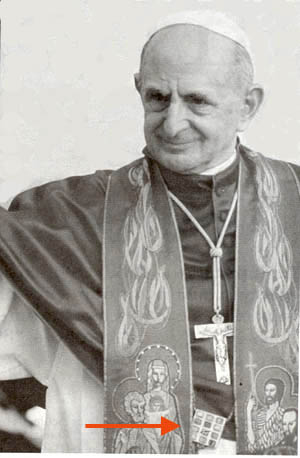
Paul VI Wearing the Symbol of the Jewish High-Priest
“The most Holy Roman Church firmly believes, professes and preaches that none of those existing outside the Catholic Church, not only pagans, but also Jews and heretics and schismatics, cannot have a share in life eternal; but that they will go into the eternal fire which was prepared for the devil and his angels…” (Pope Eugene IV) |
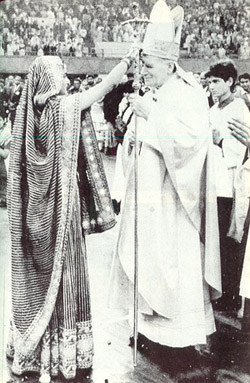
John Paul II Receives a “Blessing” From a Hindu Priestess - February, 1986.
Upon his arrival to celebrate a Novus Ordo “Mass” at a stadium in New Delhi, India, a smiling John Paul II receives a "blessing" from a Hindu woman. |
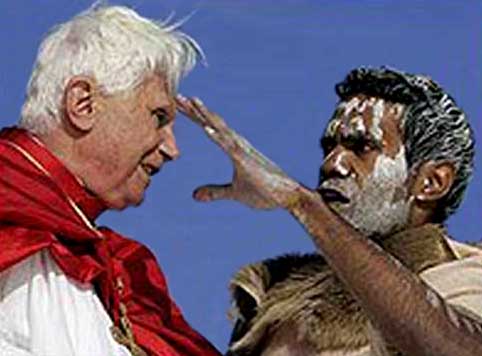
The Tradition Continues...
During his stay in Sydney for the World Youth Day in 2008, Benedict XVI received a "blessing" from an Aborigine witch doctor. |

John Paul II Kneeling and Praying at the Tomb of the Heretical Gandhi in New Delhi in 1986.
In praise of the Hinduist leader he said, “Today as a pilgrim of peace, I have come here to pay homage to Mahatma Gandhi, hero of humanity.”
Mahatma Gandhi was a “devout” Hindu who said: “Hinduism as I know it entirely satisfies my soul, it fills my whole being.”
When Gandhi was asked whether he was a Hindu, he replied, "Yes I am. I am also a Christian, a Muslim, a Buddhist and a Jew." |

John Paul II Gives “Communion” to Semi-naked Natives - May 8, 1984
In a “Mass” John Paul II celebrated in Papua, New Guinea, semi-naked natives of both sexes received “Holy Communion.” Catholic standards of decency prohibit showing the volumes of more explicit depictions of bare breasted women… receiving communion from John Paul II.
Here again natives are encouraged to keep their primitive tribal “heritage” rather than to convert to a life of Christian virtue.
|

Ratzinger Gives “Communion” to a Protestant Heretic - 2005
Brother Roger Schutz, a minister of the heretical Swiss Reformed Church and founder of the Taize community, receives “Communion” from “Cardinal” Joseph Ratzinger at John Paul II's funeral in St. Peter's Square at the Vatican April 8, 2005. Every priest knows that it is a grave sin and a sacrilege to give Communion to a heretic.
|
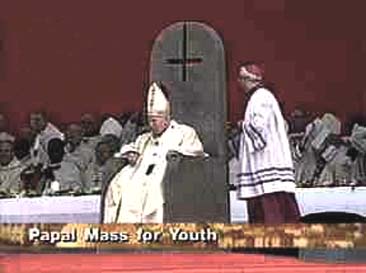
John Paul II sits on a throne with an inverted cross – March 24, 2000.
These pictures speak volumes. On his visit to the Holy Land, John Paul II chose to sit on a throne with an inverted cross on its back during a “Mass.”
“The inverted cross indicates the rejection of Jesus Christ and contempt for the gospel of salvation. Inverted symbols are typical of the opposite values pursued by Satanists.” (The Kingdom of Satan, Professor J.S. Malan.)
|
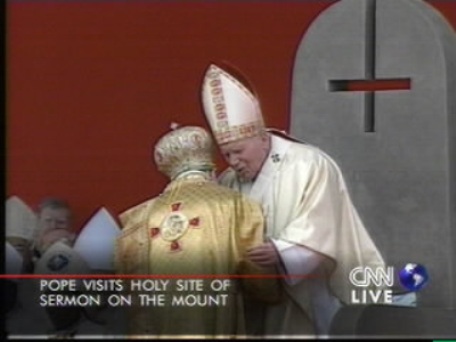 |
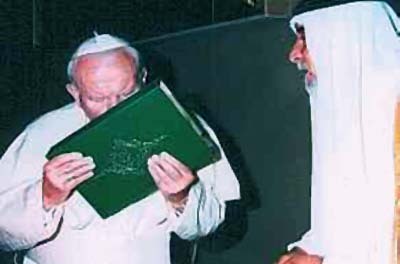
John Paul II kissing the Koran – May 14, 1999
“It belongs to faith not only that the heart should believe, but also that external words and deeds should bear witness to the inward faith, for confession is an act of faith.” (St. Thomas Aquinas [Doctor of the Church], Summa - Pt. II, Q.1, A.2)
|
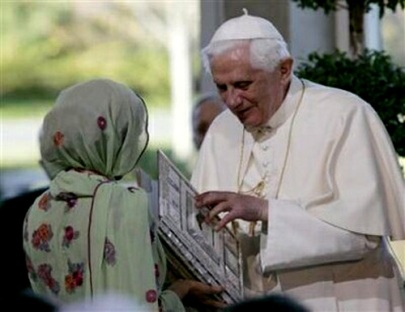
Benedict receiving the Koran
On April 17, 2008, during the inter-faith meeting, Benedict happily received an ornate, silver-plated copy of part of the Koran from a Muslim.
|
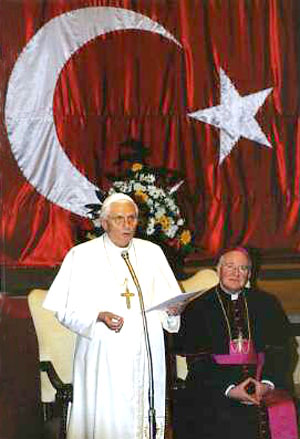
Benedict Chooses to Have as the Background Setting an Enormous Muslim Crescent – 2006
On November 28, 2006, Benedict XVI addressed ambassadors and religious leaders at the Vatican Embassy in Ankara, Turkey. He chose to have as the background setting for his speech an enormous Muslim Crescent.
|
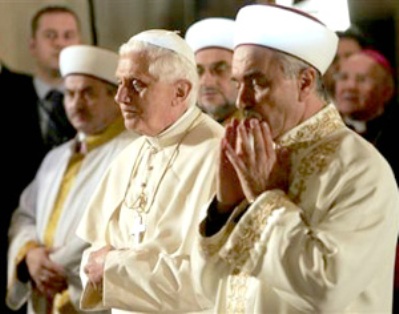
Benedict XVI “Hailed for Praying Like Muslims Toward Mecca.” - Dec 1, 2006
ISTANBUL (Reuters) – “Pope Benedict ended a sensitive, fence-mending visit to Turkey on Friday amid praise for visiting Istanbul's famed Blue Mosque and praying there facing toward Mecca ‘like Muslims.’… ‘The Pope's dreaded visit was concluded with a wonderful surprise,’ wrote Daily Aksam on its front page. ‘In Sultan Ahmet Mosque, he turned toward Mecca and prayed like Muslims.’ ”
“The Holy Universal Church teaches that it is not possible to worship God truly except in Her and asserts that all who are outside of Her will not be saved.” (Moralia, Pope St. Gregory the Great, 590 – 604)
|
John Paul II Performing his Routine Freemasonic Tribute to “Holy Mother Earth”
|
|
“When Louis XVI was executed, the work was half done; and thenceforward the Army of the Temple was to direct all its efforts against the Pope.” (Morals & Dogma of the Ancient and Accepted Scottish Rite of Freemasonry, 1871)
|
THE PROPER USE OF RIGHT REASON
In applying simple logic to the small sampling of errors given above, an inescapable conclusion must necessarily be reached. The hard facts:
Over the span of nearly 2,000 years, 261 Popes have consistently and unanimously taught, to the whole Church, the same doctrines on faith and morals, without exception. Over the last 50 plus years and 5 “popes” these doctrines have been changed and contradicted to such an extent that they have become significantly different and arguably heretical. Now, two contradictory “truths” cannot both be correct, so who is right and who is wrong? Is it possible that the first Pope, chosen by Christ Himself, and His 260 successors in office for nearly 2,000 years have been teaching error in the Catholic Church? And that only NOW, since Vatican Council II, we have been given the truth? After founding His Church on the “rock” of Saint Peter (Matt. 16:18) and promising to be with it “all days, even to the consummation of the world” (Matt. 28:20), do we now discover that Christ lied to us, that He had not been with the Church He founded all this time, and thereby allowed billions of Catholics for nearly 2,000 years to be led astray by false teachers? And that just now, after 2,000 years, He has finally decided to keep His promise?! To believe so would be absolutely ridiculous and blasphemous! Christ could not lie to us, nor could HIS Church ever lead us astray.
It is of Faith that Christ cannot err or teach error.17It is of Faith that Christ is the Head of the Catholic Church.18 Therefore, any church that teaches error cannot have Christ for its Head or be Catholic.
The church that emerged from Vatican Council II teaches error; therefore it cannot have Christ for its head; therefore it cannot be Catholic. It is that simple.
HEAVEN HAS BEEN WARNING US OF DIRE TIMES
Without question, outside of Noah, we live in a time without historical precedent. We see perversion everywhere, even in the holy places. Jesus forewarned us of a great falling away from the Faith:
“But yet the Son of man, when He cometh, shall He find, think you, faith on earth?” (Luke 18:8)
He also told us about the desecration of the holy place:
“When therefore you shall see the abomination of desolation, which was spoken of by Daniel the prophet, standing in the holy place: he that readeth let him understand…” (Matt. 24:15) “For there shall arise false Christs and false prophets, and shall show great signs and wonders, insomuch as to deceive (if possible) even the elect. Behold I have told it to you, beforehand.” (Matt. 24:24, 25)
The Mother of God has not been silent either. For centuries the Most Blessed Virgin Mary has been warning us of a great falling away from the Faith, including Rome itself.
 The Seers of La Salette The Seers of La Salette |
In 1846 Our Lady appeared in La Salette, France and spoke to two shepherd children of upcoming calamities. A large basilica was built on the site of the apparitions after numerous accounts of miraculous healings were reported and verified. Our Holy Mother, the Catholic Church investigated this apparition and declared it “worthy of belief.”
“Many will abandon the Faith, and great shall be the number of priests and religious who shall separate themselves from the true Religion… Lucifer, with a great number of demons will be unchained from Hell. By degrees they shall abolish the Faith, even among persons consecrated to God… Many religious houses will entirely lose the Faith, and shall be the cause of the loss of many souls… The earth shall abound with evil men and the spirit of darkness shall spread over the earth a universal relaxation about everything relating to the service of God… Tremble, you who profess to serve Jesus Christ, but inwardly worship yourselves, for God has delivered you to His enemies, because corruption is in the holy places… the abomination [Novus Ordo] shall be seen in holy places… Rome will lose the Faith and become the seat of Antichrist…”
In 1917, in Fatima, Portugal, Our Lady appeared to three children and entrusted to them several secrets. This apparition is also approved by the Church. Below is an accurate account of part of the “third secret” as it was published in “Neues Europa” in 1963.
“Satan rules even in the highest positions and determines the direction of things. He will succeed in worming his way even into the highest summits of the Church… But this will be a time of great trials for the Church. Cardinals will oppose cardinals. Bishops will oppose bishops. Satan will walk in their ranks. In Rome, there will be great changes. What is rotten will fall and what will fall will never rise again. Darkness will envelope the Church…”
| |
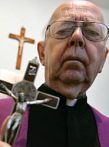 Gabriele Amorth ‒‒ The Vatican's chief exorcist for over 25 years, published his Memoirs of an Exorcist in March, 2010: Gabriele Amorth ‒‒ The Vatican's chief exorcist for over 25 years, published his Memoirs of an Exorcist in March, 2010:
“The Devil is at work inside the Vatican... When one speaks of the 'smoke of Satan' in the holy rooms, it is all true... cardinals who do not believe in Jesus, and bishops who are linked to the Demon... |
|
CAN SO MANY BE WRONG AND SO FEW BE RIGHT?
The sad reality is that the “majority” do not save their souls, as Our Lord Jesus Christ Himself told us:
“Enter ye in at the narrow gate: for wide is the gate, and broad is the way that leadeth to destruction, and many there are who go in thereat. How narrow is the gate, and straight is the way that leadeth to life: and few there are that find it!” (Matt. 7:13, 14)
St. Anselm comments on this passage:
“If thou wouldst be certain of being in the number of the elect, strive to be one of the few, not of the many. And if thou wouldst be quite sure of thy salvation, strive to be among the fewest of the few… Do not follow the great majority of mankind, but follow those who enter upon the narrow way, who renounce the world, who give themselves to prayer, and who never relax their efforts by day or by night, that they may attain everlasting blessedness.” (Fr. Martin Von Cochem, The Four Last Things, p. 221
Prophecy has predicted a time in which the faithful Catholics would constitute only a tiny minority:
“The Church will be punished because the majority of Her members, high and low, will become so perverted. The Church will sink deeper and deeper until She will at last seem to be extinguished, and the succession of Peter and the other Apostles to have expired. But, after this, She will be victoriously exalted in the sight of all doubters.” (St. Nicholas von Flue, Mystic (1417-87)
There is also historical precedent for a large majority falling away from the Faith. This happened on a universal scale in the 4th century during the time of the Arian heresy. William Jurgens, Faith of Our Fathers:
“At one point in the Church’s history, only a few years before Saint Gregory Nazianzus’ present preaching (A.D. 380), perhaps the number of Catholic bishops in possession of sees, as opposed to Arian bishops in possession of sees, was no greater than something between 1% and 3% of the total. Had doctrine been determined by popularity, today we should all be deniers of Christ and opponents of the Spirit.”
“In the time of the Emperor Valens (4th century), Saint Basil the Great was virtually the only orthodox Bishop in all the East who succeeded in retaining charge of his see… If it has no other importance for modern man, a knowledge of the history of Arianism should demonstrate at least that the Catholic Church takes no account of popularity and numbers in shaping and maintaining doctrine: else, we should long since have had to abandon Saint Basil and Saint Hilary and Saint Athanasius and Saint Liberius and Ossius and call ourselves after Arius.”
WHAT TO DO?
We are all answerable to God for living and practicing the One, Holy, Catholic, Apostolic Faith that He and the True Catholic Church have taught us. Following the majority out of the Faith, as was done during the time of the Arian heresy, will not excuse us before God’s judgment tribunal. Our obligation to remain faithful to Catholicism is not diminished by what others choose to do, no matter their number.
In these dark and troublesome times, we need more than ever to be faithful to Christ and the Church which He shed His Precious Blood to establish. To succeed in this, we need more than ever before in the history of world the aid of the Queen of Heaven, the “destroyer of all heresies” – Mary, the Holy Mother of God. We need to pray our Rosaries as she requested in every apparition at Fatima. We need to study and learn our true Holy Catholic Faith. We need to consecrate ourselves to Mary’s Immaculate Heart, as she has so often requested, particularly at Fatima.
Listen to her consoling and yet terrible words which she addressed to all of us at Marienfried, Germany, where she appeared in 1946:
“I am the powerful Mediatrix of Graces… I place my sign on the foreheads of my children (those who consecrate themselves to my Immaculate Heart). The star (Lucifer) will persecute the sign, but my sign will conquer the star. Have unreserved confidence in my Immaculate Heart… Substitute my Immaculate Heart in place of your sinful hearts… The star of the infernal regions will rage more violently than ever and will cause frightful destruction, because he knows that his time is short, and because he sees that already many have gathered around my sign. Over these he has no spiritual power… Pray, make sacrifices for sinners. Offer yourselves and your works to the Father through me, and put yourselves at my disposal without reserve. Pray the Rosary… After this, the devil will be possessed of such power that those who are not firmly established in me will be deceived… establish everything on confidence (in my Immaculate Heart). The devil has power over all people who do not trust in my Heart. Wherever people substitute my Immaculate Heart for their sinful hearts, the devil has no power. But he will persecute my children. They will be despised, but he can do them no harm.”
________________________________
1(Malachias 3:6) "[T]he Father of lights, with whom there is no change, nor shadow of alteration." (James 1:17)
2"God himself, who makes the revelation and can neither deceive nor be deceived." (Vatican Council, Sess. 3, 1870)
3"The Church was founded immediately and personally by the true historical Christ during the time of His earthly life." (Pope St. Pius X, Oath Against Modernism, 1910)
4We make the distinction between Vatican Council and “Vatican Council II”, insignificant though it may seem, because Vatican Council II was not an orthodox and thereby valid Council. Although historically it took place, in the eyes of God and of His Church, just like other false Councils, it has no weight or power.
5“Go, therefore, and make disciples of all nations...teaching them to observe all that I have commanded you; and behold, I am with you all days, even unto the consummation of the world.” (Matthew 28:19-20)
6De Romano Pontifice, II. c. 26
7lib. 4, epist. 2
8Scr. 2 cont. Arian.
9lib. De great. Christ. Cap. 20
10contra Lucifer.
11A Catholic Dictionary, Don Attwater, 1958, citing Canon 1325, section 2.
12“In the examination of any rite for the effecting and administering of Sacraments, distinction is rightly made between the part which is ceremonial and that which is essential, the latter being usually called the matter and form.” (Apostolicae Curae, Pope Leo XIII, 1896)
13“The most essential function of the sacrerdotal office is sacrifice. ‘For every high priest is appointed to offer gifts and sacrifices.’ (Heb. 8:3)” (Fundamentals of Catholic Dogma, Ludwig Ott, 1955). “Sacrifice and priesthood are, through God’s ordinance, so connected with each other that both existed in every order of salvation.” [order of salvation – Old Law and New Law] (Council of Trent, Sess. 23)
14“The Roman Catechism is a work of exceptional authority. At the very least it has the same authority as a dogmatic Encyclical - it is an authoritative exposition of Catholic doctrine given forth, and guaranteed to be orthodox by the Catholic Church and her supreme head on earth.” (Preface to the Catechism of the Council of Trent, 1923, John McHugh, O.P., Charles Callan, O.P.)
15Catechism of the Council of Trent, On the Sacrament of the Eucharist.
16“[T]he episcopal consecration of one who was not already a priest would be null and void.” (The Teaching of the Catholic Church, Canon G. Smith, Vol. 2, XXIX, iv) “The majority of theologians and canonists, are of the opinion that episcopal consecration requires the previous reception of priest's orders for its validity,” (Catholic Encyclopedia, Holy Orders – Subject, 1914)
17Vatican Council I, Sess. 3
18“He (Christ) is the Head of the Body, the Church” (Col. 1:18); “The Church represents one single Mystical Body, whose Head is Christ.” Unam Sanctam, Pope Boniface VIII, (1302).
Bishop Joseph Marie @ bishopjosephmarie.org














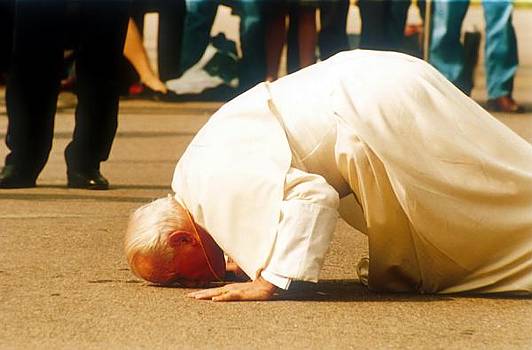


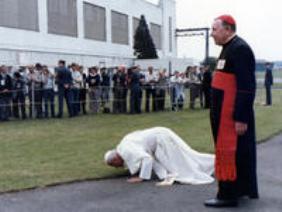
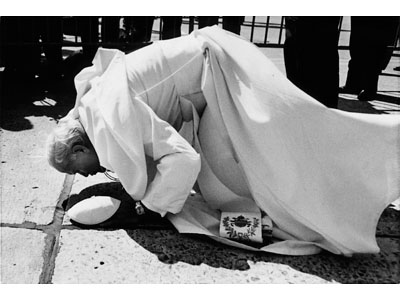
 The Seers of La Salette
The Seers of La Salette Gabriele Amorth ‒‒ The Vatican's chief exorcist for over 25 years, published his Memoirs of an Exorcist in March, 2010:
Gabriele Amorth ‒‒ The Vatican's chief exorcist for over 25 years, published his Memoirs of an Exorcist in March, 2010: